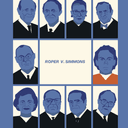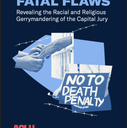
In an op-ed written for the 25th anniversary of the U.S. Supreme Court’s decision in McCleskey v. Kemp, nationally acclaimed death penalty expert James Acker (pictured) called for a reassessment of how race is affecting death penalty decisions. Prof. Acker questioned the Court’s refusal to find bias in the wake of the strong statistical evidence presented in that case. He wrote, “The time has surely come for a sober reassessment of this ruling” and “we must question if justice truly has been served when racial prejudices influence capital case decisions.” Acker noted that the recent case involving the shooting of Trayvon Martin by George Zimmerman in Florida raises the question of “how confident [we can be] that the pernicious influence of race has been expunged from punishment by death?” Read full commentary below.
Life, death and race — -How color-blind is justice, especially in capital cases?
25 years ago today, on April 22, 1987, the Supreme Court decided McCleskey vs. Kemp, a case widely regarded as presenting the last broad-based constitutional challenge to the death penalty in America. Warren McCleskey, a black man, was sentenced to death in Georgia for murdering Frank Schlatt, a white police officer. A study by professor David Baldus revealed that death sentences in the state were significantly more likely in white-victim murder cases than in comparable black-victim murders. The race of the murder victim proved to be more pivotal in life and death decisions than such legally relevant factors as whether the offender had a prior conviction for a capital crime. Race effects were especially pronounced in cases like McCleskey’s, where the defendant was black and the victim white.
In a 5 – 4 ruling, the justices dismissed the constitutional significance of the documented racial disparities. Justice Lewis Powell’s majority opinion reasoned that McCleskey had not proven that the prosecutor or jury in his own case had been influenced by race. The statistical evidence reflecting statewide capital charging and sentencing decisions was deemed irrelevant to that critical point.
Yet how could McCleskey have shown that racial biases infected his own trial?
Would a prosecutor or a juror who allowed racial considerations to affect a charging or sentencing decision be willing to admit it? If racial prejudices operate subconsciously, might even well-intentioned decision-makers be unaware of their influence?
And why did a majority of the Supreme Court turn a blind eye to the undeniable legacy of race discrimination that the statistical study had captured in stark, numerical form?
Between the conclusion of the Civil War and ratification of the 14th Amendment with its promise of the equal protection of the laws, slavery had given way in Georgia and other Southern states to the so-called Black Codes, which assigned different punishments, including death, to blacks and whites who committed the same crime.
Sophisticated studies were not needed to appreciate that race and capital punishment went hand in hand deep into the 20th century when, for example, 9 out of every 10 men executed for rape were black and almost invariably had been convicted for violating white women.
We can only speculate about whether racial stereotyping and prejudices played a role just weeks ago, when George Zimmerman shot and killed Trayvon Martin in a gated community in Sanford, Fla. Whatever ensued between those private citizens unfolded and escalated rapidly, demanding split-second judgments imbued with layers of ambiguity. It is altogether different to wonder how the Supreme Court, speaking with calm deliberation and as the font of America’s most fundamental constitutional values, could have allowed Warren McCleskey to be executed with the imprint of race stamped so clearly on Georgia’s death penalty law.
Some maintain that “unequal justice is still justice” — that the convicted murderer of a police officer, such as McCleskey, should not be heard to complain even if race was a factor in his execution. It has been argued, by analogy, that black motorists who exceed the speed limit are not treated unjustly when issued traffic citations even if white motorists driving just as fast are not cited. Speeding is speeding. Just deserts are just deserts, even if not equally distributed.
Still, it is odd to be asked to sacrifice equality for justice when the facade of the Supreme Court building — bearing the words, “Equal Justice Under Law” — suggests that both must be served. And we must question if justice truly has been served when racial prejudices influence capital case decisions.
Whether anyone deserves to die as punishment for a crime demands moral judgments that are infinitely more complex, subtle and elusive than whether a driver has exceeded the speed limit.
The debate over whether capital punishment promotes or undermines justice must certainly presume its color-blind administration. Today, 25 years after the McCleskey vs. Kemp ruling, and with the country’s harsh reawakening to issues implicating race, laws, and justice with the tragic shooting death of Trayvon Martin, how confident can we be that the pernicious influence of race has been expunged from punishment by death?
Were he alive today, Lewis Powell would be among those expressing doubts. Powell retired from the Supreme Court in 1987, just months after he wrote the lead opinion in McCleskey vs. Kemp.
He later confided to his biographer that given the chance he would have changed his vote in McCleskey and, indeed, “in any capital case.” Those second thoughts came too late for Warren McCleskey, who died in Georgia’s electric chair in 1991.
The time has surely come for a sober reassessment of this ruling.
James R. Acker is a professor in the University at Albany School of Criminal Justice, and co-author, most recently, of “Wrongful Conviction: Law, Science, and Policy.” He is a founder of the university’s National Death Penalty Archive, the most comprehensive repository of scholarship and material devoted to capital punishment in America
(J. Acker, “Life, death and race — How color-blind is justice, especially in capital cases?,” Albany Times-Union, April 22, 2012). See Race and U.S. Supreme Court. Listen to DPIC’s Podcast on Race.



